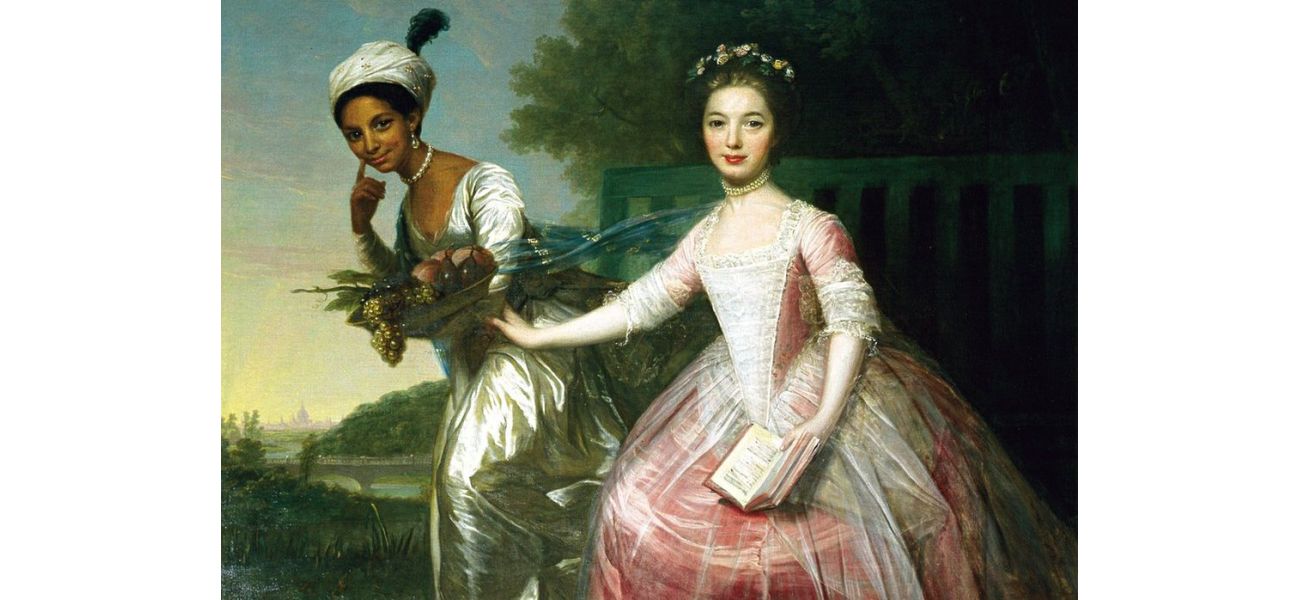A portrait of two young women on a palace wall holds great significance.
Dido's story continues to hold secrets waiting to be revealed.
November 1st 2024.

Dido, the elegant lady portrayed in this painting, was born into a prestigious family in Georgian Britain. Her cousin Elizabeth, who is also depicted in the portrait, was her constant companion and dear friend. However, it wasn't until screenwriter Misan Sagay stumbled upon this painting at Scone Palace that the story of Dido truly came to life and captured the hearts of many.
As a medical student at the University of St Andrews, Misan found herself in the wrong room at Scone Palace. But the moment she laid eyes on the painting, she was mesmerized. Two young women, one with fair skin and the other with darker complexion, seemed to stare back at her, inviting her into their world. Misan was so captivated that she momentarily forgot about the party she was supposed to attend just down the hall.
"It was the equality between the two women in the painting that struck me," Misan later shared. "I was intrigued and wanted to know more." Years later, when she returned to Scone Palace, she was delighted to find that the portrait had been moved to a more prominent room, with the names "Dido and Elizabeth" now displayed below it. This discovery led Misan to delve deeper into the fascinating history of Dido, a woman of mixed race who defied societal norms and held her own among the British aristocracy.
Misan's interest in Dido's story sparked the creation of the screenplay for the movie "Belle", which was released in 2013. As a medical professional working for the NHS, Misan's work on the film allowed her to share Dido's story with a wider audience, and people were eager to learn more about this remarkable woman.
Dido's portrait can still be viewed at Scone Palace in Scotland, where the current resident, Viscount Stormont William Murray, lives with his family. The palace, which sees around 100,000 visitors each year, holds a rich history as the site of the first Scottish Parliament and the original home of the Stone of Destiny, a significant symbol in Scottish history.
On a crisp autumn day, the Viscount graciously welcomed Metro into the palace, accompanied by his loyal dog Filo. After exchanging pleasantries, he led us to the Ambassador's Room, where the painting of Dido and Elizabeth hangs proudly next to a magnificent canopy bed and an antique table.
As he gazed at the painting, the Viscount pointed out the striking differences between the two women. "Elizabeth's attire is more traditional, with a heavily corseted dress that was not commonly worn during the time the painting was created in the early 1770s," he explained to Metro. "She holds a heavy book and appears quite stiff, representing the old world and Old England. On the other hand, Dido's dress is more flowing, and she wears a turban with an ostrich feather. She also holds a bowl of fruit, symbolizing the new world. With Elizabeth reaching out to her, it's like the old world meeting the new."
But who was Dido Belle? She was born in 1761 to Admiral Sir John Lindsay, a British Navy captain who had sailed in the Caribbean, and an African slave named Maria Belle. At a young age, Dido was sent to live with her great-uncle, the 1st Earl of Mansfield, and his wife Elizabeth Finch, while her mother was sent to America. The reason for their separation is still unknown.
Dido quickly bonded with her cousin Elizabeth, who was a year older and had lost her mother during childbirth. Dido's great-uncle and aunt, who were known for their generosity, took her in as their own. The two cousins became inseparable, sharing a room and playing together on the grounds of Kenwood House, where they lived.
As an adult, Dido became her great-uncle's private secretary and was responsible for writing letters to important members of British society. This was a task usually reserved for men, but Dido proved to be a capable and trusted member of the household. She was also given the keys to the dairy, a prestigious responsibility in a time when wealthy women prided themselves on breeding cows. However, despite her intelligence and contributions, Dido was not allowed to sit at the dinner table with important guests, due to society's outdated views on race and illegitimate birth.
One particular incident was recorded by Thomas Hutchinson, a colonial governor of Massachusetts, during his visit to London. He wrote in his diary, "A Black came in after dinner and sat with the ladies, and after coffee, walked with the company in the gardens, one of the young ladies having her arm within the other... He [the 1st Earl] calls her Dido, which I suppose is all the name she has. He knows he has been reproached for showing a fondness for her - I dare say not criminal."
During Dido's time, England's economic power was fueled by slave labor in the Caribbean and its colonies. However, as people began to realize the cruelty of this practice, the tides started to turn. Dido's great-uncle, the 1st Earl, was the Lord Chief Justice from 1756 to 1788, making him the most powerful judge in the country. In 1772, he made a landmark decision in the case of James Somerset, a slave who sought freedom after being brought to England. The 1st Earl declared that the slave trade was "odious" and could not be supported. This ruling set a precedent for future cases and added momentum to the movement to end slavery throughout the British Empire.
Another significant event that took place during Dido's time at Kenwood House was the Zong massacre. A merchant ship carrying 130 African slaves to Jamaica ran out of supplies, and the crew threw them overboard. The owners of the ship tried to claim insurance for their "lost cargo", but the insurers refused to pay. When the case reached the 1st Earl, he sided with the insurers and found the crew guilty of the massacre.
"All of these events happened while Dido was living under my great-uncle's roof," the Viscount shared proudly. Dido's story continues to inspire and captivate people, and her portrait at Scone Palace serves as a reminder of her remarkable life and the important role she played in history.
Dido, the beautiful woman in the painting, was not just any ordinary woman. She came from an aristocratic family in Georgian Britain, and her life was about to take a dramatic turn when Misan Sagay, a medical student, stumbled upon her portrait in Scone Palace. Misan was instantly captivated by the painting of two young women, one fair-skinned and the other Black, both staring out at her. She was so taken by the painting that she forgot about the party she was supposed to attend, just a few corridors away.
As Misan later recalled, "They were equals in that painting. I was struck, intrigued." This encounter sparked Misan's curiosity and she delved deeper into the history of the woman in the painting, Dido. She discovered that Dido was an illegitimate, mixed-race woman who defied the norms of British aristocracy and made a name for herself. Misan was so inspired by Dido's story that she wrote a screenplay for the movie "Belle", which was released in 2013 while she was working for the NHS. The movie brought Dido's story to a wider audience, and people were eager to learn more about her.
Dido's portrait can now be found in a prominent room in Scone Palace, with the names "Dido and Elizabeth" added below. Visitors to the palace, which welcomes over 100,000 people a year, can not only admire the grandeur of the estate but also walk in the footsteps of pagan leaders and Christian kings. It is the original home of the Stone of Destiny, an ancient block of red sandstone used to crown Scottish monarchs such as Macbeth and Robert the Bruce.
As we speak, Viscount Stormont William Murray, a descendant of Dido's uncle, lives on the estate with his family. On a crisp autumn day, he meets me with his dog Filo at his feet and takes me to the Ambassador's Room, where the painting of Dido and her cousin Elizabeth is displayed beside a canopied bed and antique table. The Viscount, 35 years old, points out the stark contrast between the two women in the painting. "Elizabeth is wearing an old-fashioned dress, heavily corseted, which wouldn't have been common at the time the painting was made in the early 1770s," he explains. "She holds a heavy book and is in a fixed position, representing the old world and Old England. On the other hand, Dido's dress is more fluid, and she wears a turban with an ostrich feather, holding a bowl of fruit. She represents the new world. The two women reaching out to each other symbolize the meeting of the old and the new."
But who exactly was Dido Belle? Born in 1761, she was the daughter of British Navy captain Sir John Lindsay and an African slave named Maria Belle. When Dido arrived at Kenwood House, the home of her uncle, the 1st Earl of Mansfield, she struck up a friendship with her cousin, Elizabeth, who was just one year older than her. Despite being illegitimate, Dido was given a privileged upbringing and even became the 1st Earl's private secretary as an adult. She was responsible for writing letters to important members of British society and was even trusted with the keys to the dairy by her aunt.
However, there was one key difference between Dido and Elizabeth. Due to society's outdated views on Black people and those born out of wedlock, Dido was not allowed to sit at the dinner table with important guests. There is a historic account of this by Thomas Hutchinson, a colonial governor of Massachusetts, who visited the Mansfield family. He wrote in his diary, "A Black came in after dinner and sat with the ladies, and after coffee, walked with the company in the gardens, one of the young ladies having her arm within the other...He [the 1st Earl] calls her Dido, which I suppose is all the name she has. He knows he has been reproached for showing a fondness for her - I dare say not criminal."
Dido lived during a time when England's economic power was heavily reliant on slave labor in the Caribbean and British colonies. However, her great-uncle, the 1st Earl, who was the most powerful judge in the country, went against the norm and showed his support for the abolition of slavery. In 1772, he ruled in favor of a slave named James Somerset, who had sought freedom after being brought to England. This landmark ruling sent shockwaves through society and brought attention to the inhumane treatment of slaves. The 1st Earl also played a crucial role in another significant event - the Zong massacre. When the case reached him in 1781, he sided with the insurers who had refused to pay for the lives of 130 African slaves who were thrown overboard during a voyage to Jamaica. This decision added momentum to the movement to end slavery throughout the British Empire.
Dido's story is a testament to the old world meeting the new, and her portrait continues to inspire people to this day. As we look at her painting in Scone Palace, we are reminded of a woman who defied societal norms and made a name for herself in a time when it was not easy to do so. Dido may have lived under the roof of the 1st Earl of Mansfield, but she left a lasting legacy that will continue to be remembered for generations to come.
As a medical student at the University of St Andrews, Misan found herself in the wrong room at Scone Palace. But the moment she laid eyes on the painting, she was mesmerized. Two young women, one with fair skin and the other with darker complexion, seemed to stare back at her, inviting her into their world. Misan was so captivated that she momentarily forgot about the party she was supposed to attend just down the hall.
"It was the equality between the two women in the painting that struck me," Misan later shared. "I was intrigued and wanted to know more." Years later, when she returned to Scone Palace, she was delighted to find that the portrait had been moved to a more prominent room, with the names "Dido and Elizabeth" now displayed below it. This discovery led Misan to delve deeper into the fascinating history of Dido, a woman of mixed race who defied societal norms and held her own among the British aristocracy.
Misan's interest in Dido's story sparked the creation of the screenplay for the movie "Belle", which was released in 2013. As a medical professional working for the NHS, Misan's work on the film allowed her to share Dido's story with a wider audience, and people were eager to learn more about this remarkable woman.
Dido's portrait can still be viewed at Scone Palace in Scotland, where the current resident, Viscount Stormont William Murray, lives with his family. The palace, which sees around 100,000 visitors each year, holds a rich history as the site of the first Scottish Parliament and the original home of the Stone of Destiny, a significant symbol in Scottish history.
On a crisp autumn day, the Viscount graciously welcomed Metro into the palace, accompanied by his loyal dog Filo. After exchanging pleasantries, he led us to the Ambassador's Room, where the painting of Dido and Elizabeth hangs proudly next to a magnificent canopy bed and an antique table.
As he gazed at the painting, the Viscount pointed out the striking differences between the two women. "Elizabeth's attire is more traditional, with a heavily corseted dress that was not commonly worn during the time the painting was created in the early 1770s," he explained to Metro. "She holds a heavy book and appears quite stiff, representing the old world and Old England. On the other hand, Dido's dress is more flowing, and she wears a turban with an ostrich feather. She also holds a bowl of fruit, symbolizing the new world. With Elizabeth reaching out to her, it's like the old world meeting the new."
But who was Dido Belle? She was born in 1761 to Admiral Sir John Lindsay, a British Navy captain who had sailed in the Caribbean, and an African slave named Maria Belle. At a young age, Dido was sent to live with her great-uncle, the 1st Earl of Mansfield, and his wife Elizabeth Finch, while her mother was sent to America. The reason for their separation is still unknown.
Dido quickly bonded with her cousin Elizabeth, who was a year older and had lost her mother during childbirth. Dido's great-uncle and aunt, who were known for their generosity, took her in as their own. The two cousins became inseparable, sharing a room and playing together on the grounds of Kenwood House, where they lived.
As an adult, Dido became her great-uncle's private secretary and was responsible for writing letters to important members of British society. This was a task usually reserved for men, but Dido proved to be a capable and trusted member of the household. She was also given the keys to the dairy, a prestigious responsibility in a time when wealthy women prided themselves on breeding cows. However, despite her intelligence and contributions, Dido was not allowed to sit at the dinner table with important guests, due to society's outdated views on race and illegitimate birth.
One particular incident was recorded by Thomas Hutchinson, a colonial governor of Massachusetts, during his visit to London. He wrote in his diary, "A Black came in after dinner and sat with the ladies, and after coffee, walked with the company in the gardens, one of the young ladies having her arm within the other... He [the 1st Earl] calls her Dido, which I suppose is all the name she has. He knows he has been reproached for showing a fondness for her - I dare say not criminal."
During Dido's time, England's economic power was fueled by slave labor in the Caribbean and its colonies. However, as people began to realize the cruelty of this practice, the tides started to turn. Dido's great-uncle, the 1st Earl, was the Lord Chief Justice from 1756 to 1788, making him the most powerful judge in the country. In 1772, he made a landmark decision in the case of James Somerset, a slave who sought freedom after being brought to England. The 1st Earl declared that the slave trade was "odious" and could not be supported. This ruling set a precedent for future cases and added momentum to the movement to end slavery throughout the British Empire.
Another significant event that took place during Dido's time at Kenwood House was the Zong massacre. A merchant ship carrying 130 African slaves to Jamaica ran out of supplies, and the crew threw them overboard. The owners of the ship tried to claim insurance for their "lost cargo", but the insurers refused to pay. When the case reached the 1st Earl, he sided with the insurers and found the crew guilty of the massacre.
"All of these events happened while Dido was living under my great-uncle's roof," the Viscount shared proudly. Dido's story continues to inspire and captivate people, and her portrait at Scone Palace serves as a reminder of her remarkable life and the important role she played in history.
Dido, the beautiful woman in the painting, was not just any ordinary woman. She came from an aristocratic family in Georgian Britain, and her life was about to take a dramatic turn when Misan Sagay, a medical student, stumbled upon her portrait in Scone Palace. Misan was instantly captivated by the painting of two young women, one fair-skinned and the other Black, both staring out at her. She was so taken by the painting that she forgot about the party she was supposed to attend, just a few corridors away.
As Misan later recalled, "They were equals in that painting. I was struck, intrigued." This encounter sparked Misan's curiosity and she delved deeper into the history of the woman in the painting, Dido. She discovered that Dido was an illegitimate, mixed-race woman who defied the norms of British aristocracy and made a name for herself. Misan was so inspired by Dido's story that she wrote a screenplay for the movie "Belle", which was released in 2013 while she was working for the NHS. The movie brought Dido's story to a wider audience, and people were eager to learn more about her.
Dido's portrait can now be found in a prominent room in Scone Palace, with the names "Dido and Elizabeth" added below. Visitors to the palace, which welcomes over 100,000 people a year, can not only admire the grandeur of the estate but also walk in the footsteps of pagan leaders and Christian kings. It is the original home of the Stone of Destiny, an ancient block of red sandstone used to crown Scottish monarchs such as Macbeth and Robert the Bruce.
As we speak, Viscount Stormont William Murray, a descendant of Dido's uncle, lives on the estate with his family. On a crisp autumn day, he meets me with his dog Filo at his feet and takes me to the Ambassador's Room, where the painting of Dido and her cousin Elizabeth is displayed beside a canopied bed and antique table. The Viscount, 35 years old, points out the stark contrast between the two women in the painting. "Elizabeth is wearing an old-fashioned dress, heavily corseted, which wouldn't have been common at the time the painting was made in the early 1770s," he explains. "She holds a heavy book and is in a fixed position, representing the old world and Old England. On the other hand, Dido's dress is more fluid, and she wears a turban with an ostrich feather, holding a bowl of fruit. She represents the new world. The two women reaching out to each other symbolize the meeting of the old and the new."
But who exactly was Dido Belle? Born in 1761, she was the daughter of British Navy captain Sir John Lindsay and an African slave named Maria Belle. When Dido arrived at Kenwood House, the home of her uncle, the 1st Earl of Mansfield, she struck up a friendship with her cousin, Elizabeth, who was just one year older than her. Despite being illegitimate, Dido was given a privileged upbringing and even became the 1st Earl's private secretary as an adult. She was responsible for writing letters to important members of British society and was even trusted with the keys to the dairy by her aunt.
However, there was one key difference between Dido and Elizabeth. Due to society's outdated views on Black people and those born out of wedlock, Dido was not allowed to sit at the dinner table with important guests. There is a historic account of this by Thomas Hutchinson, a colonial governor of Massachusetts, who visited the Mansfield family. He wrote in his diary, "A Black came in after dinner and sat with the ladies, and after coffee, walked with the company in the gardens, one of the young ladies having her arm within the other...He [the 1st Earl] calls her Dido, which I suppose is all the name she has. He knows he has been reproached for showing a fondness for her - I dare say not criminal."
Dido lived during a time when England's economic power was heavily reliant on slave labor in the Caribbean and British colonies. However, her great-uncle, the 1st Earl, who was the most powerful judge in the country, went against the norm and showed his support for the abolition of slavery. In 1772, he ruled in favor of a slave named James Somerset, who had sought freedom after being brought to England. This landmark ruling sent shockwaves through society and brought attention to the inhumane treatment of slaves. The 1st Earl also played a crucial role in another significant event - the Zong massacre. When the case reached him in 1781, he sided with the insurers who had refused to pay for the lives of 130 African slaves who were thrown overboard during a voyage to Jamaica. This decision added momentum to the movement to end slavery throughout the British Empire.
Dido's story is a testament to the old world meeting the new, and her portrait continues to inspire people to this day. As we look at her painting in Scone Palace, we are reminded of a woman who defied societal norms and made a name for herself in a time when it was not easy to do so. Dido may have lived under the roof of the 1st Earl of Mansfield, but she left a lasting legacy that will continue to be remembered for generations to come.
[This article has been trending online recently and has been generated with AI. Your feed is customized.]
[Generative AI is experimental.]
0
0
Submit Comment





